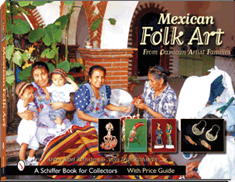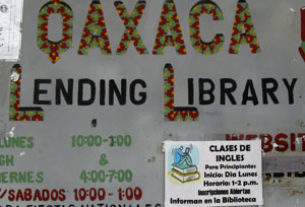This month features a rather unusual volume. At first glance it appears to be one of those handsome coffee table books full of colorful photographs – and, in a way, there’s a very definite element of that about it. However, a closer look reveals that this is a volume with much, much more going for it.
Arden Rothstein and her daughter Anya are both afficionados of Oaxacan artistry and they’ve put together a wonderful tribute in this one book. Arden is the one who tells the stories about these artists and their work. And Arden and Anya, who is still in her teens, both shared the photographic responsibilities.
Arden, when she isn’t in Oaxaca, is a psychoanalyst and clinical psychologist in private practice in New York City. According to the jacket cover she took her family to share some beloved memories of three summers she herself spent there 40 years ago. Daughter Anya was immediately intrigued as was her mother when she was in her teens. The idea for the book came out of that visit along with their desire to pay tribute to the many artists they met on their visit.
Not only are there hundreds of photos of all kinds of artistic output, from pottery to wood carvings, from basket weaving to candle making, and lots more but we’re given a much closer look at the actual creators of all this work than you will normally find in such a book. We’re treated to wonderful works featuring mermaids, clowns, devils, angels, fishes, skeletons, biblical scenes, animals and birds of all kinds (real and imagined), and even ladies of the night. These are all used to decorate masks, bedspreads, candles, baskets, jewelry, furniture, statues, toys, pottery and clothing and much, much more. It all adds up to a generous creative feast.
One of the most unusual features is that there are some 87 brief biographies of each of the artists whose creative efforts are featured throughout. The bios make for interesting reading because they form a kind of social document that adds another dimension to the book. We get glimpses of the lives of these people. They even contain the odd surprise. There’s the occasional university grad among them and a man who won an award to study basketry in China.
I particularly liked the Day of the Dead section. It really makes you realize what a unique and distinctive society thrives here in Mexico with all of its customs and traditions, all still very much alive.
Also quite striking as you read these personal stories is the strength and prevalence of the family ties that are exhibited throughout. Some 44 families are featured in the book and it isn’t unusual in looking through the photos to see three generations seated around a table or workbench. There’s an almost religious aspect to this approach to working. As one of the artists remarks: “A whole family working in clay is like a plant that eternally flowers.”
All of them seemed to have started learning and creating at a very early age – as young as six years old in many cases, and the tradition continues today. There’s even one woman who claims she started learning her craft when she was three years old. The parents all appear to accept that they have an obligation to teach their offspring the techniques they themselves have practised all their lives. “We worry that this work carried out with great effort and love will not be sustained by the next generation,” says one senora whose specialty is dried flower crafts. It would appear that she needn’t worry about the children not picking up on the family tradition.
For those people who are interested in artistic techniques and processes there are also many sections on how each artist achieves his or her results and where the various working materials were found. All of the book’s sections are beautifully organized and it’s easy to locate the individual topics you might be interested in.
Yet another unusual feature of Mexican Folk Art is that there’s price on every item in the book so, if you like, you could also call it a kind of high class sales catalog. For each of the artists there’s an address and phone number so, presumably, you can make purchases. Or, if you visit Oaxaca, there are maps showing where you can find each of the 44 family workshops.
It’s a few years since my wife and I were in Oaxaca. Our purpose in going was not to study or purchase art objects. Rather, it was to attend a Spanish course. And we found it a most enjoyable month-long stay. It’s a lovely area to visit. However, when we go back you can rest assured we’ll be looking in on a few of these workshops. And I’ll make sure I take my copy of Mexican Folk Art along with me.
I liked the quote of Quirino Santiago Cruz: “Oaxaca is a place where people like to work to preserve their traditions. Thanks to artesanías I have a wonderful life.”
I think Sr. Cruz is on to something. When I look at some of the awful things that are going on in the world all I can say is that I think Planet Earth needs more places like Oaxaca with its civilized family values and its continuity and traditions, to say nothing of its abundant creativity. And here’s a wonderful book that pays tribute to all of that.
And one final item: this book comes with its own website. It’s www.oaxacanfolkart.com
Check it out.
In my humble O: Good one! Now, let me see…. my birthday is coming up soon and I really like those whimsical woodcarvings of various animals. I wonder if they take Visa….?

Mexican Folk Art. From Oaxacan Artist Families
By Arden Aibel Rothstein and Anya Leah Rothstein
Schiffer Publishing Limited. 2002
Available from Amazon Books: Paperback

